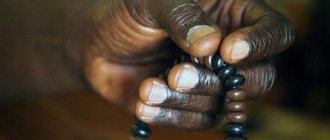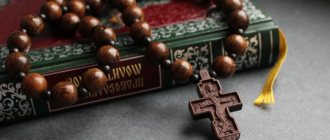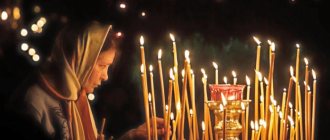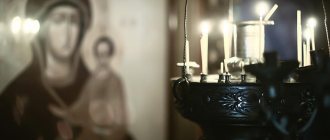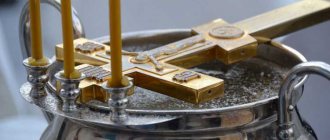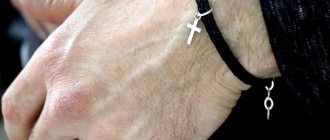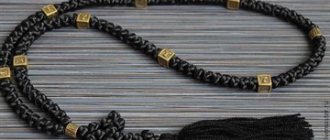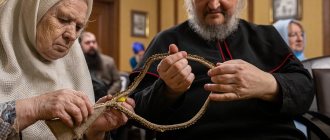Rosary is an ancient attribute of church rituals of all religions. In the explanatory dictionary V.I. Dahl writes: “A rosary (from counting, honor) is a string of beads, a belt with knots, used in cathedrals for counting prayers and bows.”
But the rosary is also a unique healing tool. Simply fingering the rosary with your fingers can relieve various diseases, calm the nerves, relieve fatigue, and increase the overall tone of the body.
Rosary beads are an individual item, so it is not advisable to transfer them to anyone for temporary use. After practicing with the rosary, it is recommended to release the tension from it with a wave of your hand and wipe it with a dry cloth. Store this unique item in a dry place and carry it in a cloth bag.
Types of Orthodox rosary
Rosaries in Orthodoxy are divided into three types:
- Ladder - from Old Russian means “ladder”, which implies the path from earth to the throne of Heaven. They belong to the Old Believer tradition. They are a strip of leather with cords sewn onto it. She can often be seen depicted on icons in the hands of Seraphim of Sarov.
- Lestovka is a slightly modified version of the ladder. It has a round shape. In the old days, rolled up pieces of paper with the Jesus Prayer, as the Old Believers called it, were placed in each roller. After the split, the lestovka was finally supplanted by the vervitsa.
- Vervitsa - is a looped rope or cord with knots tied on it or large beads strung on it, located at an equal distance from each other.
In the middle there must be a Cross - an instrument of the redemption of humanity, a symbol of victory over death.
Classification
In the Eastern Christian tradition, there are two types of this religious attribute. The number of grains is usually a multiple of 10 (10, 30, 40, 50, 100 or 1000).
- The most ancient lestovki are considered primordially Orthodox rosaries. These days they are rarely used. Their origin is connected with vervitsa (a simple Byzantine rope) with knots formed on it. The term “ladder” symbolizes the staircase to the Heavenly abode. Such rosaries do not look like beads, but like a leather belt, along the length of which there are wide loops (bobbins). To learn how to use this Old Believer attribute, you should carefully study its structure. Prayerful praises here are briefly worded and addressed to the Savior, the Virgin Mary and other saints.
- The rosary is a modern form, characterized by conciseness and simplicity, they are extremely common in the Orthodox tradition. The idea of popularizing these rosaries in Russia belongs to Seraphim of Sarov, who introduced the Mother of God rule of reading. On each individual bead the corresponding prayer is read.
Vervitsa is the oldest type of rosary.
How many beads should there be in an Orthodox rosary?
Traditionally in Orthodoxy the number of “grains” is a multiple of ten. Most often it is 10, 20, 50. Monastic ones contain up to 1000.
Sometimes you can find a rosary with 33 beads, each for a year of Jesus Christ’s life on earth.
Orthodox rosary in the online store of Orthodox icons Svyatsy.
Terms of use
Simultaneously with the beginning of the sincere recitation of the religious hymn, the believer moves the “beads” with his left hand. Each “grain” on this religious attribute symbolizes a prayer for Jesus Christ. On each large “bead” it is allowed to read the well-known “Our Father” or praise to the Virgin Mary, or something similar in spirit.
A believer can say prayers in his own way, but with great humility and openness. Theophan the Recluse taught how to use the rosary in the following way:
- First you need to say a petition for pardon and transfer one “bead” between your fingers. This algorithm continues further, and for each prayer a bow and bow to the ground are required (as the believer wishes).
- If an Orthodox believer notices that he is in a hurry to perform the ritual, it is necessary to make up for the time with new prayers and bows.
- To determine the duration, you should independently determine how much time is spent on the ritual during Matins and Vespers, and how many times the rosary itself is passed. A certain number will become an individual measure in the prayer service. Since people are diligent and lazy (busy), they set the time for praise differently.
On a note! In Sarov there is a certain method of working with rosaries, which can be taken as an example for every believer. First, 30 bows to the ground are performed with the praise of Jesus, then 100 prayer services without bows; the second circle is repeated in exactly the same way, and the third involves 20 bows with praise of the Son of God and 100 ordinary prayers; finally, 20 bows and 100 prayers to the Virgin Mary.
However, the rules are chosen individually; the church provides a large number of them.
Old Believer staircase
How to use Orthodox rosary
First of all, lay people need to receive the blessing of their confessor, since wearing a rosary is a monastic destiny. After all, not every person is guided by true humility and repentance, and not by pride. In addition, you need to know how to wear the rosary and how to pray with it.
It is necessary to hide them from prying eyes, and under no circumstances twist them, play with them, or use them as an accessory.
It should be remembered that the rosary is an object of reverence, and should be treated accordingly. For the laity, an inconspicuous ring rosary with ten beads would be a good choice.
The main task of the rosary is to maintain rhythm, because the word “rosary” itself means “to count.” The worshiper moves the beads with his fingers, and for each of them he reads the Jesus Prayer, and when he reaches the largest one, he reads the Most Holy Theotokos or the Creed.
If necessary, in this way you can contact the Saints or the Guardian Angel, say any prayers. If the person praying is in solitude, then after every decade a bow is made, either to the ground or from the waist.
Some interesting facts
Any rosary differs from ordinary beads precisely in that the “grains” are arranged freely along the cord, making them easier to sort through.
So you bought yourself a rosary. How to spin this set of beads? In the world, beads are usually fingered with one hand. To do this, put a cord with beads on the edge of the palm, and throw the “grains” with your thumb, slightly resting each of them on the side of the index finger. And when reading prayers, the rosary is twisted with both hands, focusing attention on each bead for a long time while the sacred text is spoken.
In the Middle Ages, a priest who had just undergone tonsure was given a rosary as a symbolic weapon of faith. And in the general Christian tradition, a monk who was defrocked, that is, a clergyman who refused to serve, had his rosary taken away along with his cross.
Now you know what a rosary is. We also tried to explain in detail how to twist or, rather, sort through these beads and what they are needed for. Now you can go shopping!
How to learn to weave Orthodox rosaries according to the pattern
In fact, there is nothing difficult about making rosary beads yourself, with your own hands, having first asked for the blessing of the priest.
To begin with, you should practice on the simplest knot pattern, and then you can move on to more elegant and complex ones. The main task is to tie the required number of knots. At the end of each ten there should be a large bead.
The pattern of weaving Orthodox rosaries begins from left to right, stepping back some distance from the edge of the cord or rope. That is, the leftmost node will be the first, and the countdown begins from there.
When the required number of knots are tied, we close the circle with one large knot or large bead, as a result, both ends of the cords should be directed downwards. Three more knots are tied on them, at the end of which a cross is suspended, which must be consecrated, bought in a church shop.
DIY making
You can make a rosary for yourself or use it as a gift for family or friends. They are used as a religious attribute, an accessory that emphasizes an image, or an object that calms the nerves. To make rosary beads with your own hands, you need to study their history and purpose. After all, they will be useful only if they are made according to all the rules.
We recommend studying Psalm 142
Material quality
The correct rosary is made only from natural materials: stone, precious metals, wood, organic glass. When selecting raw materials, you should understand for what purpose the souvenir is needed:
- juniper will help scare away evil spirits or get rid of bad influences;
- pearls or rock crystal remove obstacles in life and increase the immunity of its owner;
- a gold, silver, copper or amber product will increase the life expectancy of its owner, add wisdom and fortitude to him;
- cedar helps relieve headaches, reduces blood pressure, and improves sleep.
Process steps
All rosaries have a certain structure. They consist of beads strung on a strong fishing line. Between them at certain intervals there are separator beads. A must-have is the guru bead, which represents different objects in different faiths.
To make Buddhist rosary, you will need:
- beads - 107 pcs.;
- strong thread;
- rope;
- large bead - 1 pc.;
- scissors;
- glue.
The beads must be the same size. They are strung on a strong thread. It's best if it's fishing line. After each element you should tie a knot. It symbolizes connection with the Universe and helps to focus on meditation. After all the elements are put on, you need to make and secure the main guru bead. In Buddhism, it consists of two tassels with beads.
Making a tassel for a rosary is quite easy. To do this, you need to wrap the threads around three fingers so as to get a neat circle from a bunch of threads. The resulting tight ring is tied with thread on one side and cut in half on the other. The ends of the brush are uneven, so they need to be trimmed slightly with scissors. Then, using knots and glue, two beads are secured and the product is ready.
To make a rosary from beads with your own hands, you do not need any special abilities or skills. If you have the necessary materials at hand, then the accessory should work out.
What types of rosary are there?
Each of the world's major religions has its own types of rosary, which perform not only prayer, but also meditative and ritual functions.
The Catholic rosary, which looks like a necklace with a cross, is worn on the hand around the wrist, like a bracelet, or in a belt.
Among Muslims, rosary beads are called subha or “whip for the devil”; they usually have 99 beads, each of which is associated with the names of Allah. Rosaries with 11 beads are also common - according to the number of continuous steps in prayer.
Buddhist rosary mala, "garland" in Sanskrit, have 108 grains. In Buddhism, the purpose of beads depends on the material from which they are made. It can be crystal, copper and even human or animal bones. Some are used for reciting mantras and inducing trance, while others are used for protection from evil beings.
What are church rosaries made of?
Most often, since ancient times, wood and leather were used for these purposes, but for simple, ascetic rosaries, even a simple rope and any dried berries or wooden beads were used.
Materials for making rosaries vary from the simplest to the most expensive and sophisticated - there really is a lot to choose from.
Especially valuable are rosaries made of semi-precious stones, pearls, ivory and silk cords. Nowadays there are even plastic rosaries.
It is not for nothing that in monasticism the rosary is called a “spiritual sword”, because with their help it is much easier to feel a connection with God, without being distracted by everyday thoughts and temptations. The monotonous sorting of beads helps to concentrate one’s internal attention on prayer, which means to cleanse oneself and become spiritually healthier, to strengthen the soul, and along with it the spirit.
